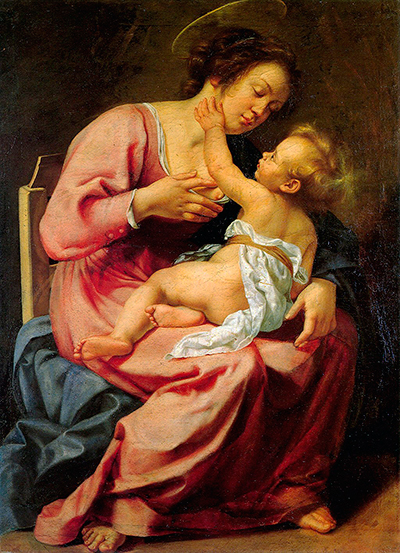Artemisia Gentileschi made a portrait of a religious scene on oil and canvas using the Baroque style of art in 1613. The celebrated Italian artist Artemisia Gentileschi has used technology to capture the complexity of the female form.
It shows beautiful tender love radiating from mother to child to depict the strength of a woman convincingly. The original painting is well preserved in the Galleria Spada in Rome. Madonna and child art represents an intimate portrait of a troubled Mary's breastfeeding a baby, capturing the power of Gentileschi’s women. The artist apprehends a quite unusual profound moment with senses of intense tension and obscure symbolism. The child is holding on firmly to the woman’s arm while covertly looking into the distance with dark and solemn eyes. The child has dug in greedily into the woman’s skin, biting her breast sufficiently enough to draw blood. The face of the suffering woman has turned away from the child with her pallid feature and heavy-lidded eyes showing signs of amnesia probably from the blood loss.
Madonna and the Child captures a trademark power of Artemisia’s painting with her grotesque richness in color and a skeptical consideration to detail. The vibrant turquoise of the woman’s pink dress and the perfect great use of a background shadow create a sense of naturalism and realism. Instead of overly sexualizing the woman in the painting, Artemisia takes a rather conservative approach to the art. She uses partial nudity on the woman to emphasize the material intimacy of the scene. Her illustration of female strength is portrayed by the Woman’s large size and dominance of the picture compositing. The woman is a perfect representation of the role of women in giving and sustaining life, and her vast size and art dominance portray a woman’s body and strength.
She went beyond authentication to express the physical and emotional world of women in her art. She skillfully showed her knowledge in different light and dark shade to illustrate the sentimental mood of the art as she stressed on the physical and psychological depths in females. The artist drew great inspiration from her father, who also trained her. A feminist by nature, most of her work portrayed strong and warrior-like female characters as the main subject. She was a pioneer for women's right representatives, thereby paving a new way for the preceding feminist artists. Her success is mainly pegged on the artistic quality and the aesthetic value of her artworks.




